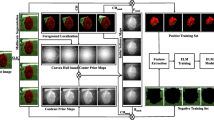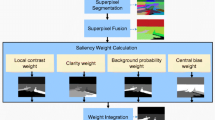Abstract
As an important problem in computer vision, saliency detection is essential for image segmentation, super-resolution, object recognition, etc. In this paper, we propose a novel method for saliency detection on image using region contrast and machine learning approaches. An image boundary extension-based general framework is proposed that can be used for all rarity- or sparsity-based schemes to improve their performances. Then, a saliency map based on boundary extension and region contrast is constructed. Due to its unsatisfactory performance, another saliency map combining supervised locality-preserving projection and support vector regression is built, to complement the previous saliency map. A final saliency map can be obtained by fusing these two saliency maps. The proposed method is evaluated on the publicly available dataset MSRA-1000 and compared with 13 state-of-the-art methods. Experimental results indicate that the proposed method outperforms existing schemes both in qualitative and quantitative comparisons.

















Similar content being viewed by others
References
Frintrop, S.: VOCUS: A Visual Attention System for Object Detection and Goal-Directed Search. Springer, Berlin (2006).
Borji, A., Itti, L.: State-of-the-art in visual attention modeling. IEEE Trans. Pattern Anal. Mach. Intell. 35, 185–207 (2013)
Treisman, A.M., Gelade, G.: A feature integration theory of attention. Cogn. Psych 12, 97–136 (1980)
Koch, C., Ullman, S.: Shifts in selective visual attention: towards the underlying neural circuitry. Human Neurobiol. 4, 219–227 (1985)
Mishra, A.K., Aloimonos, Y.: Active segmentation. Int. J. Humanoid Robot. 6, 361–386 (2009)
Donoser, M., Urschler, M., Hirzer, M., et al.: Saliency driven total variation segmentation. Proceedings of ICCV, pp. 817–824 (2009)
Sadaka, N., Karam, L.J.: Efficient perceptual attentive super-resolution. Proceedings of ICIP, pp. 3113–3116 (2009)
Shi, L., Wang, J., Xu, L., et al.: Context saliency based image summarization. Proceedings of the IEEE International Conference on Multimedia and Expo, pp. 270–273 (2009)
Navalpakkam, V., Itti, L.: An integrated model of top-down and bottom-up attention for optimizing detection speed. Proceedings of CVPR (2006).
Han, S., Vasconcelos, N.: Biologically plausible saliency mechanisms improve feedforward object recognition. Vis. Res. 50(22), 2295–2307 (2010)
Frintrop, S.: General object tracking with a component-based target descriptor. Proceedings of ICRA, pp. 4531–4536 (2010)
Borji, A., Ahmadabadi, M.N., Araabi, B.N., et al.: Online learning of task-driven object-based visual attention control. Image Vis. Comput. 28, 1130–1145 (2010)
Nagai, Y.: From bottom-up visual attention to robot action learning. Proceedings of ICDL (2009)
Guo, C., Zhang, L.: A novel multiresolution spatiotemporal saliency detection model and its applications in image and video compression. IEEE Trans. Image Process. 19(1), 185–198 (2010)
Rosenholtz, R., Dorai, A., Freeman, R.: Do predictions of visual perception aid design? ACM Trans. Appl. Percept. 8(2), 1–27 (2011)
Hong, B.W., Brady, M.: A topographic representation for mammogram segmentation. LNCS, 2879 (2003)
Ma, Q., Zhang, L., Wang, B.: New strategy for image and video quality assessment. J. Electron. Imaging 19(1), 011019–011019-14 (2010)
Parikh, N., Itti, L., Weiland, J.: Saliency-based image processing for retinal prostheses. J. Neural Eng. 7(1), 016006-1–016006-10 (2010)
Cheng, M.M., Zhang, G.X., Mitra, N.J., et al.: Global contrast based salient region detection. Proceedings of CVPR, pp. 409–416 (2011)
Wei, Y.C., Wen, F., Zhu, W.J., et al.: Geodesic saliency using background priors. Proceedings of ECCV (2012).
Itti, L., Koch, C., Niebur, E.: A model of saliency-based visual attention for rapid scene analysis. IEEE Trans. Pattern Anal. Mach. Intell. 20(11), 1254–1259 (1998)
Walther, D., Koch, C.: Modeling attention to salient proto-objects. Neural Netw. 19(9), 1395–1407 (2006)
Vikram, T.N., Tscherepanow, M., Wrede, B.: A saliency map based on sampling an image into random rectangular regions of interest. Pattern Recogn. 45(9), 3114–3124 (2012)
Bruce, N.D.B., Tsotsos, J.K.: Saliency based on information maximization. Proceedings of NIPS, pp. 155–162 (2005)
Torralba, A.: Modeling global scene factors in attention. J. Optical Soc. Am. 20(7), 1407–1418 (2003)
Zhang, L., Tong, M.H., Marks, T.K., et al.: SUN: a Bayesian framework for saliency using natural statistics. J. Vis. 8(7), 1–20 (2008)
Lin, Y., Fang, B., Tang, Y.: A computational model for saliency maps by using local entropy. Proceedings of the AAAI Conference on Artificial Intelligence, pp. 967–973 (2010)
Achanta, R., Hemami, S., Estrada, F., et al.: Frequency-tuned salient region detection. Proceedings of CVPR, pp. 1597–1604 (2009)
Hou, X., Zhang, L.: Saliency detection: a spectral residual approach. Proceedings of CVPR, pp. 1–8 (2007)
Yan, J., Zhu, M., Liu, H., et al.: Visual saliency detection via sparsity pursuit. IEEE Signal Process. Lett. 17(8), 739–742 (2010)
Shen, X., Wu, Y.: A unified approach to salient object detection via low rank matrix recovery. Proceedings of CVPR, pp. 853–860 (2012)
Li, Y., Zhou, Y., Xu, L., et al.: Incremental sparse saliency detection. Proceedings of ICIP, pp. 3093–3096 (2009)
Judd, T., Ehinger, K., Durand, F., et al.: Learning to predict where humans look. Proceedings of ICCV, pp. 2106–2113 (2009)
Kootstra, G., Nederveen, A., de Boer, B.: Paying attention to symmetry. Proceedings of BMVC, pp. 1115–1125 (2008)
Gopalakrishnan, V., Hu, Y., Rajan, D.: Salient region detection by modeling distributions of color and orientation. IEEE Trans. Multimed. 11(5), 892–905 (2009)
Zhao, Q., Koch, C.: Learning saliency-based visual attention: a review. Signal Process. 93(6), 1401–1407 (2013)
Zhao, Q., Koch, C.: Learning a saliency map using fixated locations in natural scenes. J. Vis. 11(3), 1–15 (2011)
Zhao, Q., Koch, C.; Learning visual saliency by combining feature maps in a nonlinear manner using AdaBoost. J. Vis. 12(6), 1–15 (2012)
Jolliffe, I.: Principal Component Analysis, 2nd edn. Springer, New York (2002)
Hastie, T., Tibshirani, R., Friedman, J.: The Elements of Statistical Learning: Data Mining, Inference and Prediction. Springer, New York (2009)
Roweis, S.T., Saul, L.K.: Nonlinear dimensionality reduction by locally linear embedding. Science 290(5500), 2323–2326 (2000)
Tenenbaum, J.B., De Silva, V., Langford, J.C.: A global geometric framework for nonlinear dimensionality reduction. Science 290(5500), 2319–2323 (2000)
Belkin, M., Niyogi, P.: Laplacian eigenmaps and spectral techniques for embedding and clustering. Proceedings of NIPS 14, pp. 585–591 (2001)
Zheng, Z., Yang, F., Tan, W., et al.: Yang, Gabor feature-based face recognition using supervised locality preserving projection. Signal Process. 87(10), 2473–483 (2007)
Yan, S., Xu, D., Zhang, B., et al.: Graph embedding and extensions: a general framework for dimensionality reduction. IEEE Trans. Pattern Anal. Mach. Intell. 29(1), 40–51 (2007)
Chen, H.T., Chang, H.W., Liu, T.L.: Local discriminant embedding and its variants. Proceedings of CVPR 2, 846–853 (2005)
Xu, Y., Zhong, A.Yang, J., et al.: LPP solution schemes for use with face recognition. Pattern Recogn. 43(12), 4165–4176 (2010)
Comaniciu, D., Meer, P.: Mean shift: a robust approach toward feature space analysis. IEEE Trans. Pattern Anal. Mach. Intell. 24(5), 603–619 (2002)
Chang, C.C., Lin, C.J.: LIBSVM: a library for support vector machines. ACM Trans. Intell. Systems Technol. 2(3), 27 (2011)
Borji, A., Sihite, D.N., Itti, L.: Salient object detection: a benchmark. Proceedings of ECCV, pp. 414–429 (2012)
Perazzi, F., Krahenbuhl, P., Pritch, Y., et al.: Saliency filters: contrast based filtering for salient region detection. Proceedings of CVPR (2012)
Goferman, S., Zelnik-Manor, L., Tal, A.: Context-aware saliency detection. Proceedings of CVPR, pp. 2376–2383 (2010)
Jiang, H., Wang, J., Yuan, Z., et al.: Salient object detection: a discriminative regional feature integration approach. Proceedings of CVPR (2013)
Harel, J., Koch, C., Perona, P.: Graph-based Visual Saliency. Proceedings of NIPS 19, 545–552 (2006)
Ma, Y.F., Zhang, H.J.: Contrast-based image attention analysis by using fuzzy growing. Proceedings of ACM MM (2003)
Achanta, R., Estrada, F., Wils, P., et al.: Salient region detection and segmentation, computer vision systems, 66–75. Springer, Berlin Heidelberg (2008)
Zhai, Y., Shah, M.: Visual attention detection in video sequences using spatiotemporal cues. ACM Multimedia, pp. 815–824 (2006)
Hou, X., Harel, J., Koch, C.: Image signature: highlighting sparse salient regions. IEEE Trans Pattern Anal. Mach. Intell. 34(1), 194–201 (2012)
Chang, K., Liu, T., Chen, H., et al.: Fusing generic objectness and visual saliency for salient object detection, ICCV (2011)
Yi, Y., Zhang, B., Kong, J., et al.: An improved locality sensitive discriminant analysis approach for feature extraction. Multimedia Tools Appl. doi:10.1007/s11042-013-1429-5.
Acknowledgments
This work was supported by the Fund of Jilin Provincial Science and Technology Department (No. 20130206042GX, No. 20140204089GX), Young Scientific Research Fund Of Jilin Province Science And Technology Development Project (No. 201201070, No. 201201063, No. 20130522115JH) and National Natural Science Foundation of China (No. 11271064).
Author information
Authors and Affiliations
Corresponding authors
Rights and permissions
About this article
Cite this article
Shi, Y., Yi, Y., Yan, H. et al. Region contrast and supervised locality-preserving projection-based saliency detection. Vis Comput 31, 1191–1205 (2015). https://doi.org/10.1007/s00371-014-1005-7
Published:
Issue Date:
DOI: https://doi.org/10.1007/s00371-014-1005-7




